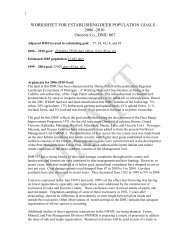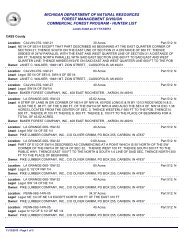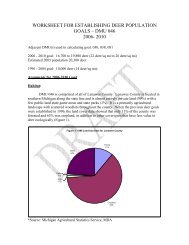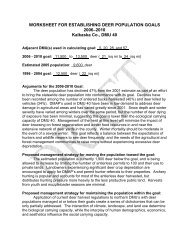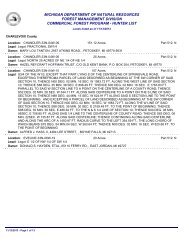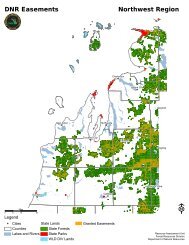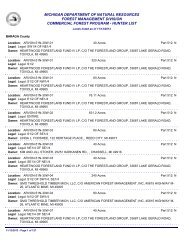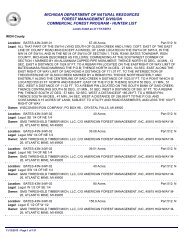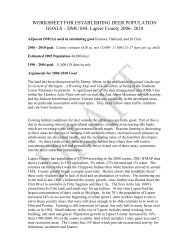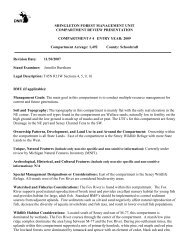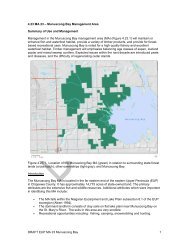Fox River Complex - Michigan Department of Natural Resources
Fox River Complex - Michigan Department of Natural Resources
Fox River Complex - Michigan Department of Natural Resources
Create successful ePaper yourself
Turn your PDF publications into a flip-book with our unique Google optimized e-Paper software.
EUP MA 11 <strong>Michigan</strong> DNR – Eastern Upper Peninsula Eco-region<br />
Attributes<br />
<strong>Fox</strong> <strong>River</strong> <strong>Complex</strong> Management Area Summary<br />
The <strong>Fox</strong> <strong>River</strong> <strong>Complex</strong> Management Area is located in the west part <strong>of</strong> the Eastern Upper<br />
Peninsula in Schoolcraft and Luce Counties, surrounding the town <strong>of</strong> Seney. It has approximately<br />
27,217 acres <strong>of</strong> state-owned land. The attributes which were important in identifying this MA<br />
include:<br />
• Ecological Classification – The majority <strong>of</strong> the MA falls within the Seney Lake Plain subsection<br />
<strong>of</strong> the EUP Ecoregion as classified by Cleland (2006).<br />
• Landforms – Landforms <strong>of</strong> lacustrine origin. Broad, poorly drained embayments contain<br />
beach ridges and depressions (swales), sand spits, transverse sand dunes, and sand bars.<br />
Deltaic deposits occur along the northern margins <strong>of</strong> the embayments, where glacial<br />
meltwater streams carried massive amounts <strong>of</strong> sand into the shallow waters.<br />
• Cultural – The famous author, Ernest Hemmingway, fished the <strong>Fox</strong> <strong>River</strong> and wrote about his<br />
experiences in the story titled “Big Two-Hearted <strong>River</strong>”. The town <strong>of</strong> Seney was at one time a<br />
large logging community.<br />
• Social / Economic – The town <strong>of</strong> Seney is in this MA at the intersection <strong>of</strong> highways M-28 and<br />
M-77. Recreational facilities found here include: snowmobile trails and boat launches on<br />
Manistique Lake and the <strong>Fox</strong> <strong>River</strong>. Fishing and hunting are very popular forms <strong>of</strong> recreation<br />
in this MA. Special fishing regulations apply to the <strong>Fox</strong> <strong>River</strong> system. There is a mineral<br />
lease for a sand pit north <strong>of</strong> Seney.<br />
• Special Features – The <strong>Fox</strong> <strong>River</strong>, East Branch <strong>of</strong> the <strong>Fox</strong> and their tributaries are designated<br />
as <strong>Natural</strong> <strong>River</strong>s, and their corridors are considered High Conservation Value Areas<br />
(HCVAs). The <strong>Fox</strong> <strong>River</strong> and the East Branch <strong>of</strong> the <strong>Fox</strong> are also trout streams. There are<br />
large potential Biodiversity Stewardship Areas (BSA) identified within the MA, and a Special<br />
Conservation Area (SCA) deer wintering yard near Manistique Lake. These special features<br />
are primary attributes for this MA.<br />
• Ownership size and connectivity – The state land in this MA is concentrated into large blocks,<br />
with private holdings scattered throughout. This management area borders the east side <strong>of</strong><br />
1
EUP MA 11 <strong>Michigan</strong> DNR – Eastern Upper Peninsula Eco-region<br />
the Seney National Wildlife Refuge. Shingleton and Newberry Units share management<br />
responsibility.<br />
Major Cover Types<br />
• Mixed Swamp Conifer – There are 5063 acres <strong>of</strong> Mixed Swamp Conifers in the MA, and over<br />
65% is over age 60. Access is <strong>of</strong>ten difficult due to wet sites.<br />
• Lowland Brush / Bog or Marsh / Marsh – Lowland brush covers 3,501 acres, bog or marsh<br />
occurs on 1,879 acres and marsh covers 1,758 acres <strong>of</strong> the MA. These cover types<br />
contribute to the access issues in the MA. These cover types also contain important habitat<br />
components, including breeding cover and winter food sources, that are used by a number <strong>of</strong><br />
wildlife species. Uncommon songbird, owl, and plant species are found in these types. This<br />
MA has some very old tag alder sites.<br />
• Black Spruce – Over 80% <strong>of</strong> the 2,495 acres <strong>of</strong> black spruce in this MA is over age 60.<br />
Harvest opportunities in some <strong>of</strong> these stands are limited by wet ground, or other access<br />
issues.<br />
• Aspen – Covers 1,848 acres in this MA. Over 75% <strong>of</strong> the aspen is in the 0-29 year age<br />
classes. Most <strong>of</strong> the aspen acres in the older age classes are inaccessible.<br />
• Northern White Cedar – Of the 1,847 acres <strong>of</strong> Cedar in the MA, most is over 70 years old,<br />
and half is over 100. Access and other conservation values have influenced the amount <strong>of</strong><br />
harvesting in this cover type.<br />
• Upland Hardwoods – Covers 1,722 acres in the northwest and southern portions <strong>of</strong> the MA.<br />
The majority <strong>of</strong> these stands are being managed as uneven aged.<br />
• Red Pine – A large amount <strong>of</strong> natural red pine stands exist on 1,709 acres in this MA. Many<br />
<strong>of</strong> these stands are found on small islands within marshes, and are <strong>of</strong>ten hard to access.<br />
There are a few planted stands <strong>of</strong> red pine as well.<br />
<strong>Fox</strong> <strong>River</strong> <strong>Complex</strong> Age Class (Years)<br />
Total<br />
Uneven<br />
Cover Type Acres % 0-9 10-19 20-29 30-39 40-49 50-59 60-69 70-79 80-89 90-99 100+ Aged<br />
Mx Swmp Cnfr 5063 19% 76 189 41 50 66 119 823 2020 386 346 92 855<br />
Lowlnd Brush 3501 13% 0 0 0 0 0 0 0 0 19 0 0 0<br />
Black Spruce 2495 9% 156 22 8 55 34 58 469 1093 450 35 12 103<br />
Bog or Marsh 1879 7% 0 0 0 0 0 0 0 0 0 0 0 0<br />
Aspen 1848 7% 333 409 658 143 106 73 58 39 6 4 0 19<br />
Cedar 1847 7% 0 0 0 4 0 0 17 77 521 219 893 116<br />
Marsh 1758 6% 0 0 0 0 0 0 0 0 0 0 0 0<br />
Upland Hdwds 1722 6% 0 3 0 1 5 23 18 44 0 9 0 1619<br />
Red Pine 1709 6% 19 0 0 2 421 198 207 348 138 167 131 78<br />
Swamp Hrdwds 1241 5% 0 0 14 8 0 59 209 110 88 0 0 753<br />
Jack Pine 861 3% 99 43 105 35 191 101 193 59 27 0 0 8<br />
Grass 704 3% 0 0 0 0 0 0 0 0 0 0 0 0<br />
Paper Birch 505 2% 0 0 5 0 20 15 4 408 0 42 0 11<br />
Tamarack 489 2% 0 14 0 3 61 54 43 85 12 29 0 188<br />
Treed Bog 426 2% 0 0 0 0 0 0 0 0 0 0 0 0<br />
White Pine 309 1% 5 0 0 0 0 85 13 0 40 29 69 68<br />
Other Types 860 3%<br />
Total 27,217<br />
Other Types include: Lowland Poplar, Non Stocked, Water, Spruce Fir, Hemlock and Upland Brush<br />
2
EUP MA 11 <strong>Michigan</strong> DNR – Eastern Upper Peninsula Eco-region<br />
Concepts <strong>of</strong> Management<br />
• Mixed Swamp Conifer (19% <strong>of</strong> the MA) and Black Spruce (9% <strong>of</strong> the area) – Where possible,<br />
conduct regeneration cuttings in a manner that will not adversely impact wetland soils or deer<br />
wintering habitat.<br />
• Lowland Brush (13% <strong>of</strong> the MA) / Bog or Marsh (7% <strong>of</strong> the MA) / Marsh (6% <strong>of</strong> the MA) –<br />
Continue to manage these large roadless areas for wildlife and other ecological concerns,<br />
primarily by allowing natural processes to occur.<br />
• Aspen (7% <strong>of</strong> the MA) – Continue to work toward balancing the age classes where access<br />
allows. Allow inoperable aspen areas to succeed to late successional species.<br />
• Cedar (7% <strong>of</strong> the MA) – Maintain closed canopy cedar within the deer wintering areas, and<br />
do not harvest cedar where cedar regeneration is unlikely. Chipping operations in other<br />
cover types adjacent to deer yards may be restricted.<br />
• Upland Hardwoods (6% <strong>of</strong> the MA) – In upland hardwood, use single-tree selection where<br />
quality warrants, and consider shelterwood or other treatments in lower quality stands.<br />
Underplant oak and disease resistant beech on suitable sites. Retain dead and down wood,<br />
snags and cavity trees within this type. Consider retaining a mesic conifer component within<br />
the canopy <strong>of</strong> these stands.<br />
• Red Pine (6% <strong>of</strong> the MA) – Manage the natural red pine stands using shelterwood/seed tree<br />
systems when possible to encourage natural regeneration. Some small island stands <strong>of</strong> red<br />
pine may never be harvested due to size and lack <strong>of</strong> access, and will be allowed to reach full<br />
biological maturity.<br />
• Other –<br />
• Observe <strong>Natural</strong> <strong>River</strong> Guidelines.<br />
• Continue the cooperative glossy buckthorn control project with the Seney National<br />
Wildlife Refuge, and the removal <strong>of</strong> scotch pine and other invasive plant species as<br />
resources allow.<br />
3



